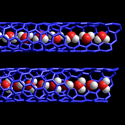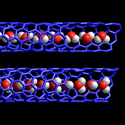Water takes its place in line
Carbon nanotubes may seem an unlikely choice for nanoscale plumbing, but simulations have shown that water both fills nanotubes and may even shoot through them at unexpectedly high flow rates. Now, writing in Physical Review Letters, Sofie Cambré and colleagues at the University of Antwerp in Belgium are using optical spectroscopy to find the narrowest carbon nanotube that will still let water molecules in.
Cambré et al. study a large number of nanotubes with a mix of different diameters, some open and some completely closed. The radial vibration frequency of the carbon nanotubes, measured spectroscopically, decreases with nanotube diameter. But in earlier work, Cambré et al. also found that in a large collection of tubes, they would always see two frequencies—separated by less than —for each nanotube diameter. They argued that the two frequencies corresponded to closed nanotubes that contained no water and open nanotubes that did.
In their current work, they follow this shift in more than types of nanotubes to gain a better picture of how the radial vibration varies with radius—particularly in different environments. But their big surprise is that water appears to fill a nanotube that is only angstroms wide. If water is filling such a narrow nanotube, it must do so single file. The new data are encouraging indications that simulations showing single-file filling are correct. – Jessica Thomas





